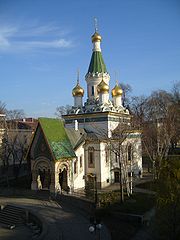
Russian Church, Sofia
Encyclopedia

Sofia
Sofia is the capital and largest city of Bulgaria and the 12th largest city in the European Union with a population of 1.27 million people. It is located in western Bulgaria, at the foot of Mount Vitosha and approximately at the centre of the Balkan Peninsula.Prehistoric settlements were excavated...
, Bulgaria
Bulgaria
Bulgaria , officially the Republic of Bulgaria , is a parliamentary democracy within a unitary constitutional republic in Southeast Europe. The country borders Romania to the north, Serbia and Macedonia to the west, Greece and Turkey to the south, as well as the Black Sea to the east...
, situated on Tsar Osvoboditel Boulevard
Tsar Osvoboditel Boulevard
Tsar Osvoboditel Boulevard is a boulevard in the centre of Sofia, the capital of Bulgaria. It lies between Orlov most to the east and Nezavisimost Square to the west, where it merges with Knyaz Aleksandar Dondukov Boulevard to form Todor Aleksandrov Boulevard west of the square...
.
History and architecture
The church was built on the site of the Saray Mosque, which was destroyed in 1882, after the liberation of BulgariaLiberation of Bulgaria
In Bulgarian historiography, the term Liberation of Bulgaria is used to denote the events of the Russo-Turkish War of 1877-78 that led to the re-establishment of Bulgarian state with the Treaty of San Stefano of March 3, 1878, after the complete conquest of the Second Bulgarian Empire, which...
by Russia from the Ottoman Empire
Ottoman Empire
The Ottoman EmpireIt was usually referred to as the "Ottoman Empire", the "Turkish Empire", the "Ottoman Caliphate" or more commonly "Turkey" by its contemporaries...
. It was built as the official church of the Russian Embassy, which was located next door, and of the Russian community
Russians in Bulgaria
Russians form the fourth largest ethnic group in Bulgaria, numbering 9,978 according to the 2011 census, and mostly living in the large urban centres, such as Sofia, Plovdiv, Varna and Burgas...
in Sofia, and was named, as was the tradition for diplomatic churches, for the patron saint of the Emperor who ruled Russia at the time, Nicholas II of Russia
Nicholas II of Russia
Nicholas II was the last Emperor of Russia, Grand Prince of Finland, and titular King of Poland. His official short title was Nicholas II, Emperor and Autocrat of All the Russias and he is known as Saint Nicholas the Passion-Bearer by the Russian Orthodox Church.Nicholas II ruled from 1894 until...
. The church was designed by the Russian architect Mikhail Preobrazhenski in the Russian Revival Style, with decoration inspired by the Muscovite Russian churches of the 17th century. The construction was supervised by the architect A. Smirnov, who was building the Alexander Nevsky Cathedral, Sofia
Alexander Nevsky Cathedral
Alexander Nevsky Cathedral may refer to various Eastern Orthodox cathedrals, all named after Russian saint Alexander Nevsky:* Alexander Nevsky Cathedral, Baku in Azerbaijan * Alexander Nevsky Cathedral, Belgrade in Serbia...
nearby. The exterior decoration of multicolored tiles was done by G. Kislichev, and the interior murals were painted by a team of artists led by Vasily Perminov, who also painted those in Alexander Nevsky Cathedral
Alexander Nevsky Cathedral, Sofia
The St. Alexander Nevsky Cathedral is a Bulgarian Orthodox cathedral in Sofia, the capital of Bulgaria. Built in Neo-Byzantine style, it serves as the cathedral church of the Patriarch of Bulgaria and is one of the largest Eastern Orthodox cathedrals in the world, as well as one of Sofia's symbols...
. The five domes are coated with gold. The bells were donated by Emperor Nicholas II.
Construction began in 1907 and the church was consecrated in 1914. The church remained open after the Russian Revolution and during the Communist period in Bulgaria (1944–1989), though priests and church-goers were carefully watched by the State Security police.
The exterior was recently restored by the Russian Government. The interior murals unfortunately are darkened by smoke from candles and from time, and are in need of restoration.
The crypt housing the remains of Saint Archbishop Seraphim is located beneath the Russian Church's main floor. Dozens of people still visit the grave of the archbishop, who died in 1950, praying and leaving notes asking for wishes to be granted.

